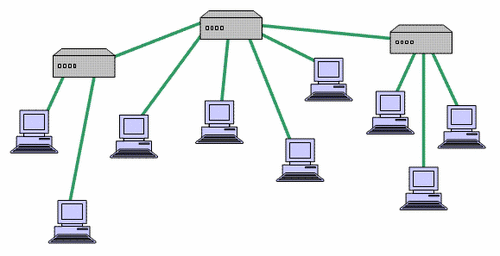The media access method, Continued....
The common media access methods are:
-Multiplexed Media Access
-Polling
-Token-Based Media Access
-Carrier Sense Multiple Access/ Collision Detection (CSMA/CD)
-Carrier Sense Multiple Access/ Collision Avoidance (CSMA/CA)
-Contention Domains
Token-Based Media Access Token-based media access is a media access method in which computers pass a special sequence of bits called a token between them.

Carrier Sense Multiple Access/Collision Detection (CSMA/CD) Carrier Sense Multiple Access/Collision Detection (CSMA/CD) is a contention-based media access method in which nodes can transmit whenever they have data to send.
They detect and manage the inevitable collisions that occur when multiple nodes transmit at once.
 Carrier Sense Multiple Access/Collision Avoidance (CSMA/CA)Carrier Sense Multiple Access/Collision Avoidance (CSMA/CA) is a contention-based media access method in which nodes can transmit whenever they have data to send.
Carrier Sense Multiple Access/Collision Avoidance (CSMA/CA)Carrier Sense Multiple Access/Collision Avoidance (CSMA/CA) is a contention-based media access method in which nodes can transmit whenever they have data to send.
The steps that they take to ensure media is unused are:

Contention Domain
A contention domain, also called a collision domain, is a group of nodes on a contention-based network that compete with each other for access to the media.

Let's move to session 3, Chapter 2...
The common media access methods are:
-Multiplexed Media Access
-Polling
-Token-Based Media Access
-Carrier Sense Multiple Access/ Collision Detection (CSMA/CD)
-Carrier Sense Multiple Access/ Collision Avoidance (CSMA/CA)
-Contention Domains
Token-Based Media Access Token-based media access is a media access method in which computers pass a special sequence of bits called a token between them.

Carrier Sense Multiple Access/Collision Detection (CSMA/CD) Carrier Sense Multiple Access/Collision Detection (CSMA/CD) is a contention-based media access method in which nodes can transmit whenever they have data to send.
They detect and manage the inevitable collisions that occur when multiple nodes transmit at once.
 Carrier Sense Multiple Access/Collision Avoidance (CSMA/CA)Carrier Sense Multiple Access/Collision Avoidance (CSMA/CA) is a contention-based media access method in which nodes can transmit whenever they have data to send.
Carrier Sense Multiple Access/Collision Avoidance (CSMA/CA)Carrier Sense Multiple Access/Collision Avoidance (CSMA/CA) is a contention-based media access method in which nodes can transmit whenever they have data to send.The steps that they take to ensure media is unused are:

Contention Domain
A contention domain, also called a collision domain, is a group of nodes on a contention-based network that compete with each other for access to the media.

Let's move to session 3, Chapter 2...


















